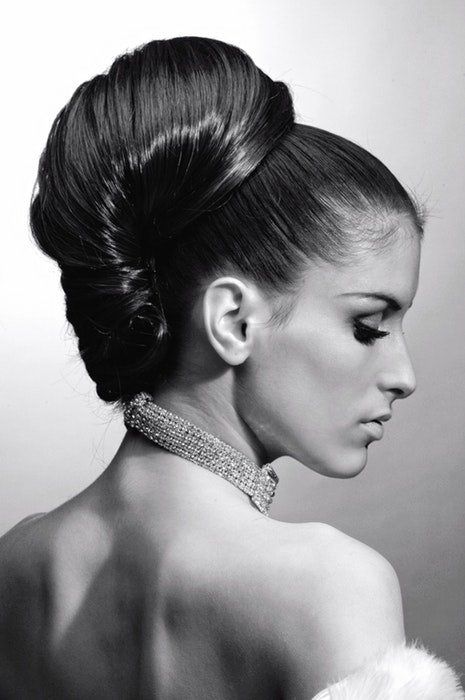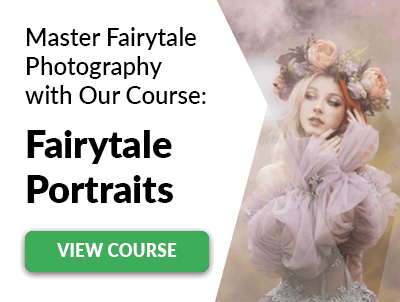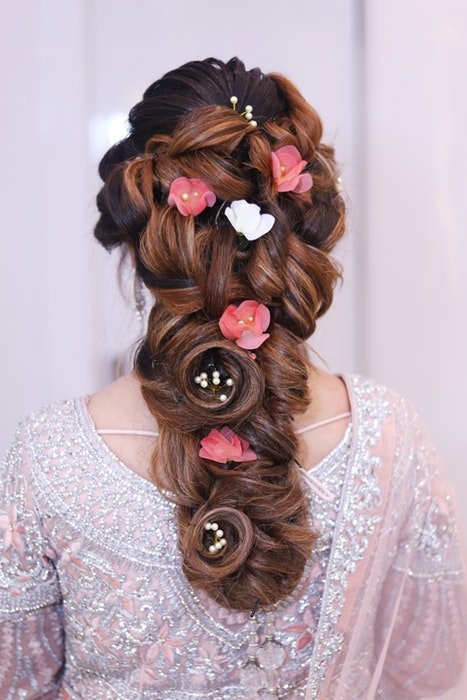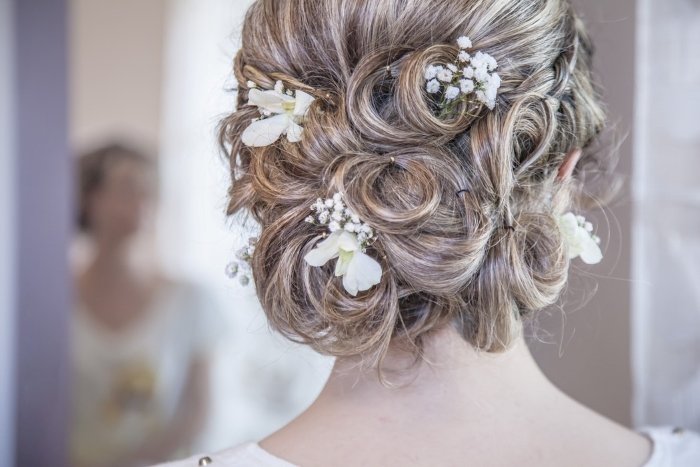But what is a hair light? And how do you add one to a studio lighting set-up? Build your next portrait photography lighting set-up with confidence using this guide.
What Is a Hair Light?
A hair light is a light that separates the hair from the background. This light is placed behind the model and directed towards the hair, creating a halo-like effect. Hair lights are particularly helpful when using the same color background as the subject’s hair, such as black hair on a black background. A hair light is often a subtle effect. The difference is easy to spot when comparing a portrait with and without a hair light. But it’s not the primary light in the photo. A hair light can be continuous or flash. Place the light behind the model and a few feet higher up. These two positions, above and behind, are most important. You can vary the look of the hair light by placing the light behind the model. Use a boom to keep the light stand out of the photo, or off to one side. In both cases, you should direct the light towards the hair, and it should not fall on any other parts of the portrait. Some hair light spilling onto the shoulders is okay, but the light shouldn’t hit the subject’s face. A hair light is also often called a rim light. But while both are similar, a hair light is placed to light the hair only. A rim light creates a halo effect or rim of light around the entire body. The rim light is placed behind the subject or behind and off to one side. But, unlike hair lights, a rim light is not always placed above the subject.
Working With a Hair Light to Create Separation and Highlights
You may want the hair light to be a subtle separation from the background, rather than a stronger, halo-like effect. Make sure to use a low power setting if this is the desired effect. The more powerful the light is, the stronger the halo effect will be. You may turn up the power if you want a bit of angelic glow. Check your shot before moving on and make sure that all the hair is visible. If a hot spot covers the hair, the light is turned too high. The detail in the hair should not be overexposed. Hair lights often use lighting modifiers to prevent the light from spilling to other parts of the image. Modifiers allow the light only to affect the hair. Some of the more popular modifiers to use with a hair light are beauty dishes, barn doors, grids, and snoots. A hair light can create separation and highlight the hair. But be careful that the light doesn’t instead exaggerate the hair’s flaws. This light can make flyaways stand out more. Have the subject smooth their hair with some hair spray if flyaways are a problem. This trick will save you lots of Photoshop work later.
Common Photography Lighting Questions
What Are the Different Types of Studio Lights?
You can place studio lights in many different ways to create different effects. Each placement has a name, definition, and purpose. Here are a few of the most common types of studio lights:
The key light or main light The fill light to fill in shadows from the key light The hair light to accent the hair The rim light to create a rim of light around an edge or edges The sidelight placed to the side The background light, directed towards the background
By combining these studio lights, you can create different creative lighting set-ups.
What Is a Kicker Light?
A kicker light is a type of lighting placement that creates small highlights on the subject. Rim and hair lights are types of kicker lights because they produce small highlights around the subject and hair.
What Is the Purpose of the Fill Light?
The fill light fills in shadows so that the details aren’t obscured by darkness. You can use fill light in a studio set-up with other lights. Fill lights are also useful when shooting outdoors to combat the dark shadows caused by the sun. This technique can prevent silhouettes and under-eye shadows. A fill light can also create catchlights in the eyes.
What Type of Light Separates the Subject from the Background?
Finally, a light with a name that’s easy to remember. The background light is a light that’s pointed towards the background. By lighting the background, you can create more separation from the subject or ensure the background is pure white. With a lighting modifier, background light can also add a gradient as the light fades in intensity from the center.
Conclusion
A hair light can be a subtle effect that helps the hair stand out from the background. You can also create a much more apparent halo of light. Working with hair lights and rim lights can help add just the right amount of pop to your portraits. When creating a lighting set-up with a hair light, remember to place the light, adjust the power, and work with modifiers to get the desired look. Looking for more great tips for photographers? Check out our creative lens flare tips or choosing the best portrait camera next!






title: “What Is A Hair Light How To Create A Halo To Highlight Hair " ShowToc: true date: “2023-01-06” author: “Jennifer Metzger”
But what is a hair light? And how do you add one to a studio lighting set-up? Build your next portrait photography lighting set-up with confidence using this guide.
What Is a Hair Light?
A hair light is a light that separates the hair from the background. This light is placed behind the model and directed towards the hair, creating a halo-like effect. Hair lights are particularly helpful when using the same color background as the subject’s hair, such as black hair on a black background. A hair light is often a subtle effect. The difference is easy to spot when comparing a portrait with and without a hair light. But it’s not the primary light in the photo. A hair light can be continuous or flash. Place the light behind the model and a few feet higher up. These two positions, above and behind, are most important. You can vary the look of the hair light by placing the light behind the model. Use a boom to keep the light stand out of the photo, or off to one side. In both cases, you should direct the light towards the hair, and it should not fall on any other parts of the portrait. Some hair light spilling onto the shoulders is okay, but the light shouldn’t hit the subject’s face. A hair light is also often called a rim light. But while both are similar, a hair light is placed to light the hair only. A rim light creates a halo effect or rim of light around the entire body. The rim light is placed behind the subject or behind and off to one side. But, unlike hair lights, a rim light is not always placed above the subject.
Working With a Hair Light to Create Separation and Highlights
You may want the hair light to be a subtle separation from the background, rather than a stronger, halo-like effect. Make sure to use a low power setting if this is the desired effect. The more powerful the light is, the stronger the halo effect will be. You may turn up the power if you want a bit of angelic glow. Check your shot before moving on and make sure that all the hair is visible. If a hot spot covers the hair, the light is turned too high. The detail in the hair should not be overexposed. Hair lights often use lighting modifiers to prevent the light from spilling to other parts of the image. Modifiers allow the light only to affect the hair. Some of the more popular modifiers to use with a hair light are beauty dishes, barn doors, grids, and snoots. A hair light can create separation and highlight the hair. But be careful that the light doesn’t instead exaggerate the hair’s flaws. This light can make flyaways stand out more. Have the subject smooth their hair with some hair spray if flyaways are a problem. This trick will save you lots of Photoshop work later.
Common Photography Lighting Questions
What Are the Different Types of Studio Lights?
You can place studio lights in many different ways to create different effects. Each placement has a name, definition, and purpose. Here are a few of the most common types of studio lights:
The key light or main light The fill light to fill in shadows from the key light The hair light to accent the hair The rim light to create a rim of light around an edge or edges The sidelight placed to the side The background light, directed towards the background
By combining these studio lights, you can create different creative lighting set-ups.
What Is a Kicker Light?
A kicker light is a type of lighting placement that creates small highlights on the subject. Rim and hair lights are types of kicker lights because they produce small highlights around the subject and hair.
What Is the Purpose of the Fill Light?
The fill light fills in shadows so that the details aren’t obscured by darkness. You can use fill light in a studio set-up with other lights. Fill lights are also useful when shooting outdoors to combat the dark shadows caused by the sun. This technique can prevent silhouettes and under-eye shadows. A fill light can also create catchlights in the eyes.
What Type of Light Separates the Subject from the Background?
Finally, a light with a name that’s easy to remember. The background light is a light that’s pointed towards the background. By lighting the background, you can create more separation from the subject or ensure the background is pure white. With a lighting modifier, background light can also add a gradient as the light fades in intensity from the center.
Conclusion
A hair light can be a subtle effect that helps the hair stand out from the background. You can also create a much more apparent halo of light. Working with hair lights and rim lights can help add just the right amount of pop to your portraits. When creating a lighting set-up with a hair light, remember to place the light, adjust the power, and work with modifiers to get the desired look. Looking for more great tips for photographers? Check out our creative lens flare tips or choosing the best portrait camera next!





